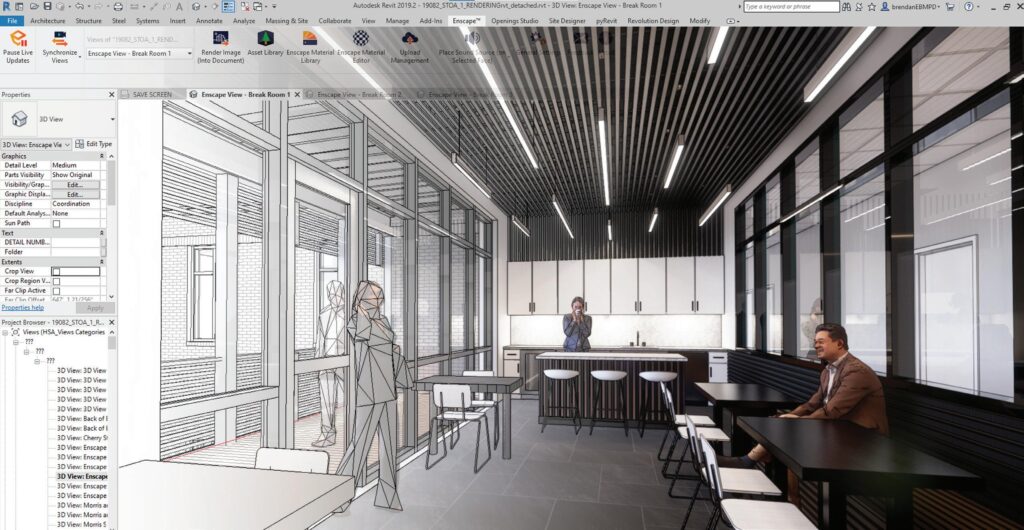
Parametric behavior of buildings in BIM systems – according to the BOB model
In work "Specifying parametric building object behavior (BOB) for a building information modeling system" authors Ghang Lee, Charles M. Eastman, and Seung-Mok Lee discuss one of the key challenges in developing BIM (Building Information Modeling) technology: how to describe behavior of buildings in a parameterized form. It is an extension of the traditional BIM approach which mainly models geometry and static data, according to a model that includes and dynamic, logical behavior of objects – so-called “parametric behavior”.
This paper presents a model called BOB (Building Object Behavior) which allows describing the rules and reactions of BIM objects to changes. In other words, instead of the user manually adjusting each element in the model, the objects “know” how to behave when a parameter changes – for example, when we change the width of a wall, the doors and windows in that wall automatically adjust.
Why is this important?
Traditional BIM models are primarily used for data storage and visualization, but they do not actively react to changes – this must be done by the user. However, in complex construction projects, even a simple change (e.g. wall thickness) can require manual corrections of dozens of other objects. Here, the BOB approach offers a significant advantage: the behavior of the objects is predefined through rules, so the model becomes dynamic and "smart".
In this way, the BIM system functions almost like a CAD + simulation platform, with built-in knowledge of what is allowed, what is possible, and what must be automatically adjusted.
What exactly is the BOB model?
BOB consists of three main components:
- Object parameters – define its characteristics (dimensions, materials, limitations)
- Behaviors – define what the object does when a parameter changes (e.g. automatically expands or moves)
- Terms and conditions – determine the validity of behavior (e.g., the width of the door must not be less than 60 cm)
The authors have developed a method by which these behaviors can be formally described and integrated into BIM tools. The goal is not only smarter modeling, but also reducing the possibility of errors, as well as speeding up iterative design.
Practical example: Door as a parametric object
Let's imagine a BIM model with a door that has the following parameters: width, height, opening method, hinge position. In the BOB approach, the behavior of that object can be:
- if the wall in which the door is installed changes, the door automatically adapts
- if the door width is reduced below the permitted limit, the system gives a warning or automatically cancels the change
- if the user changes the height of the room, the doors are scaled proportionally, but only if they are not standardized
In this way, the designer does not have to manually monitor all connections - they are already part of the object's behavior.
Connection with other research
Similar concepts appear in other research. For example:
- IFC (Industry Foundation Classes) Standards allow for the description of relationships between objects, but are not expressive enough for the precise behavior of objects.
- Generative design and tools like Autodesk Dynamo use visual programming to generate object responses to input conditions, but lack the formal structure that BOB offers.
- Ontological models from the semantic web are applied in BIM to label objects with terms and logic, but these models target interoperability more than dynamic behavior.
The BOB model stands out here because it offers a concrete methodology that combines geometric data, parameters and behavioral logic, which is very rarely integrated into a single system.
Advantages of the BOB approach
- Fewer manual errors – because objects react automatically
- Greater design efficiency – because changes propagate faster through the model
- Improved coordination between disciplines – because behaviors can include relationships between structural, architectural, and MEP elements
- Easier simulations and analyses – because the data is dynamic and responds to real changes
Limitations and challenges
Despite the clear advantages, there are challenges in implementation:
- An additional level of programming or modeling is required for each behavior
- Compatibility with standard BIM tools may be limited
- Standardization of such behaviors is not yet fully developed within existing BIM frameworks.
In addition, the introduction of this approach requires a change in the way designers think - from drawing and defining shapes, to defining the logic of behavior.
Conclusion
The BOB model presented by the authors of this paper represents an important step towards BIM models that are not only descriptive, but also reactive, adaptive and logically structuredThe introduction of parametric behavior enables faster, more precise and flexible construction project development, with the potential for integration into automated design and analysis systems.
This concept represents a bridge between static BIM and future intelligent building systems that will be able to independently recognize needs and make decisions based on rules and context.
If we want to move towards digital construction and make “smart” design the norm, models like BOB could be the foundation of that transition.





Responses